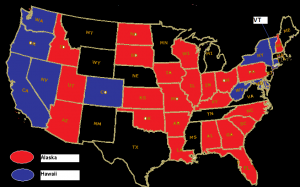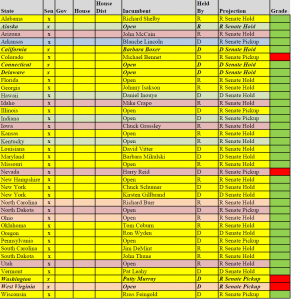Now that the will of the voters has been expressed in the 2010 midterm elections, how are we to interpret the results ? We will answer this question in the next seven posts, which will cover not only the elections just concluded, but will look into the near term (i.e., 2011 and 2012) future.
In general, the midterm elections were very favorable towards the Republicans, with the exception of the Senate. Overall, the GOP picked up 6 seats, leaving them with 47 seats – technically, the Alaska Senate race will not be settled for several weeks, but since the top two finishers are the Republican nominee (currently in second place with 34%) and the write-in Republican candidate (currently in the lead with 41%), the seat will be a GOP hold, no matter what happens once the results are certified.
Why did the GOP fail to recapture the Senate in a “wave election” like this one ? There were several factors that limited GOP gains: (1) While House elections were fought in terrain across the country, only 37 Senate races were on the ballot this year, (2) Of the Senate races on the ballot, Democrats held 20 of those seats, while Republicans held 17, which meant that even under perfect conditions, the GOP could only pick up 20 seats, (3) Of the 20 seats Democrats held, 16 were in states that voted for Barack Obama for President in 2008, with quite a few of those seats in “off limits” territory like Oregon, Maryland, New York, and Vermont, (4) The GOP had 8 open seats to defend, compared to 7 Democratic open seats – the “wave election” aspect to this year meant that none of those GOP open seats were in danger of being picked off by the Democrats, and (5) GOP primaries produced quite a few nominees with weak political skills, which resulted in numerous missed opportunities. While the “thumbs down” issued by conservative primary voters in places like Florida, Kentucky, Pennsylvania, and Utah produced strong conservative candidates who will clearly tilt the Senate towards the right, the quality of GOP nominees selected in Colorado, Connecticut, Delaware, Nevada, and West Virginia gave Democrats a bit of an electoral lift they would not have had otherwise. Just to give one example: in Nevada, the Republicans had a strong candidate for governor who defeated Harry Reid’s son 53-41% at the same time that Harry Reid defeated the gaffe prone Sharron Angle 50-45%.
Not all is lost for the GOP, however. In addition to the fact that there is clearly a more conservative tilt in its freshmen in places like Pennsylvania, Ohio, and Utah, Democrats have to defend 40 (or about 80%) of its seats in the 2012 and 2014 elections. These seats, by and large, are in more Republican friendly terrain who voted Democratic in the landslide years of 2006 and 2008. With decent candidate recruitment and/or less fractious primaries, Republicans should have little trouble picking up these Democratic seats.
In conclusion, we are attaching (1) a map of the Senate races won by the Republicans and the Democrats, and (2) a “report card” showing how good our predictions were – in this case, we correctly called 33/37 (or 89%) of the Senate races, with most of our incorrect calls coming from the West Coast. Clearly, the GOP wave ebbed in that part of the country.



[…] Continue reading at http://new.winwithjmc.com/archives/2063 […]
[…] In our previous article about the Senate, we noted that GOP gains were respectable, but were hardly overwhelming, since there were multiple missed opportunities, in addition to the fact that many Senate races were held in unfavorable terrain. These and other factors prevented the GOP from recapturing the Senate – for now. […]
JMC Enterprises of Louisiana » 2010 Midterm results: Part 1 ……
Here at World Spinner we are debating the same thing……